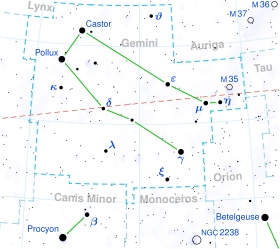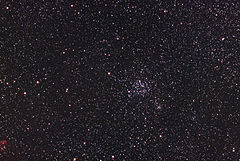(Redirected from 6 Gem )
Red supergiant star in the constellation Gemini
6 Geminorum
Observation dataEpoch J2000 Equinox J2000
Constellation
Gemini
Right ascension
06 12 19.09884
Declination
+22° 54′ 30.6531″
Apparent magnitude (V)
5.74 – 8.10
Characteristics
Spectral type
M1-2 Ia-Iab
U−B color index
+1.93
B−V color index
+1.63
Variable type
LC
Astrometry Radial velocity (Rv )+27.16±0.42 km/s Proper motion (μ) RA: +0.144 mas /yr Dec.: −2.085 mas /yr Parallax (π)0.5642 ± 0.0957 mas Distance approx. 5,800 ly pc ) Absolute magnitude (MV )−6.32 Details Mass ~20 M ☉ Radius 821+60R ☉ Luminosity 86,000 L ☉ Surface gravity (log g )0.0 cgs Temperature 3,789 K Other designations 6 Gem , BU Gem , BD +22°1220, GC 7896, HD 42543, HIP 29450, HR 2197, SAO 78098, TYC 1877-1719-1, 2MASS J06121911+2254305 Database references SIMBAD data
6 Geminorum is a variable star in the zodiac constellation of Gemini , located roughly 5,800 light years away from the Sun. It has the variable star designation BU Geminorum ; 6 Geminorum is the Flamsteed designation . At its brightest this reddish hued star is barely visible to the naked eye but is readily visible with binoculars, found southeast of M 35 , just to the south of WY Geminorum. It is moving further from the Earth with a heliocentric radial velocity of +27 km/s. The star is a member of the Gemini OB1 association .
This is an evolved red supergiant with a stellar classification of M1-2 Ia-Iab. It is a semiregular variable star , ranging from visual magnitude +5.7 down to +7.5 over a period of 325 days. It has been given the sub-classification of Lc, which means "Irregular variable supergiants of late spectral types having amplitudes of about 1 mag. in V.O". The star has expanded to 821 times the Sun's radius and is radiating 86,000 times the luminosity of the Sun from its swollen photosphere at an effective temperature of 3,789 K.
References
^ Vallenari, A.; et al. (Gaia collaboration) (2023). "Gaia Data Release 3. Summary of the content and survey properties" . Astronomy and Astrophysics . 674 : A1. arXiv :2208.00211 . Bibcode :2023A&A...674A...1G . doi :10.1051/0004-6361/202243940 . S2CID 244398875 .
Gaia DR3 record for this source at VizieR .
^ Samus, N. N.; Durlevich, O. V.; et al. (2009). "VizieR Online Data Catalog: General Catalogue of Variable Stars (Samus+ 2007-2013)". VizieR On-line Data Catalog: B/GCVS. Originally Published in: 2009yCat....102025S . 1 . Bibcode :2009yCat....102025S .
^ Keenan, Philip C.; McNeil, Raymond C. (1989). "The Perkins catalog of revised MK types for the cooler stars". Astrophysical Journal Supplement Series . 71 : 245. Bibcode :1989ApJS...71..245K . doi :10.1086/191373 .
^ Mermilliod, J.-C. (1986). "Compilation of Eggen's UBV data, transformed to UBV (unpublished)" . Catalogue of Eggen's UBV Data . Bibcode :1986EgUBV........0M .
^ Famaey, B.; et al. (January 2005). "Local kinematics of K and M giants from CORAVEL/Hipparcos/Tycho-2 data. Revisiting the concept of superclusters". Astronomy and Astrophysics . 430 (1): 165–186. arXiv :astro-ph/0409579 . Bibcode :2005A&A...430..165F . doi :10.1051/0004-6361:20041272 . S2CID 17804304 .
^ Levesque, Emily M. (2005). "The Effective Temperature Scale of Galactic Red Supergiants: Cool, but Not As Cool As We Thought". The Astrophysical Journal . 628 (2): 973–985. arXiv :astro-ph/0504337 . Bibcode :2005ApJ...628..973L . doi :10.1086/430901 . S2CID 15109583 .
"6 GEM" . 2012. Retrieved 15 December 2016.^ Norris, Ryan P. (2019). Seeing Stars Like Never Before: A Long-term Interferometric Imaging Survey of Red Supergiants Georgia State University .
^ Mauron, N; Josselin, E (2011). "The mass-loss rates of red supergiants and the de Jager prescription". Astronomy and Astrophysics . 526 : A156. arXiv :1010.5369 . Bibcode :2011A&A...526A.156M . doi :10.1051/0004-6361/201013993 . S2CID 119276502 .
^ Mármol-Queraltó, E; Cardiel, N; Cenarro, A. J; Vazdekis, A; Gorgas, J; Pedraz, S; Peletier, R. F; Sánchez-Blázquez, P (2008). "A new stellar library in the region of the CO index at 2.3 μm. New index definition and empirical fitting functions". Astronomy and Astrophysics 489 (2): 885–909. arXiv :0806.0581 . Bibcode :2008A&A...489..885M . doi :10.1051/0004-6361:200810044 . S2CID 15411613 .
"6 Gem" . SIMBAD Centre de données astronomiques de Strasbourg . Retrieved 2019-04-24.Laur, Jaan; et al. (February 2017). "Variability survey of brightest stars in selected OB associations". Astronomy & Astrophysics . 598 : 27. arXiv :1611.02452 . Bibcode :2017A&A...598A.108L . doi :10.1051/0004-6361/201629395 . S2CID 119076598 . A108.
"Variable Star Type Designations in VSX]" . Retrieved 2016-11-06."ASAS All Star Catalogue" . The All Sky Automated Survey. Retrieved 8 December 2021.
Categories :
Text is available under the Creative Commons Attribution-ShareAlike License. Additional terms may apply.
**DISCLAIMER** We are not affiliated with Wikipedia, and Cloudflare.
The information presented on this site is for general informational purposes only and does not constitute medical advice.
You should always have a personal consultation with a healthcare professional before making changes to your diet, medication, or exercise routine.
AI helps with the correspondence in our chat.
We participate in an affiliate program. If you buy something through a link, we may earn a commission 💕
↑

 A light curve for BU Geminorum, plotted from TESS data
A light curve for BU Geminorum, plotted from TESS data
 Messier 35, with 6 Gem visible right at the bottom edge of the image
Messier 35, with 6 Gem visible right at the bottom edge of the image